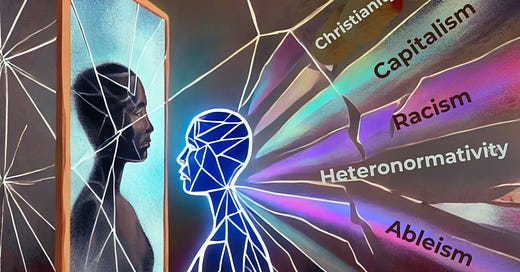Looking Within: The Radical Act of Introspection in Allyship
How Reflection Unravels Supremacy Culture and Builds the Foundations for True Liberation
Introduction:
Before we begin, I want to take a moment to express my deep gratitude to those who have chosen to support my work by subscribing. Your commitment to creating equity and sustaining this work is a profound act of introspection and the desire to understand the systems we are dismantling. As a reminder, if you wish to do this work but face financial barriers, know that support is available. You can simply message me or email scholarships@desireebstephens.com to access the resources you need.
Now, let’s pause.
Take a deep breath. Drink some water. Maybe move your body. This is grief work, a process of unraveling long-held beliefs we’ve been taught as truths and exposing the lies that uphold systems of power. It is sacred work, and it requires care—for ourselves and for one another.
In this series, we’ve explored themes like accountability, fear, and power within white communities. Today, we turn inward to examine one of the most radical tools available to dismantle supremacy culture: introspection. Often overlooked or undervalued, introspection is an act of courage, a necessary foundation for allyship that is honest, transformative, and liberatory.
This work begins with the self because allyship is not just about actions—it’s about the beliefs and values that inform them. Without deep internal reflection, allyship risks becoming performative, perpetuating harm instead of dismantling it.
Introspection as a Radical Act
Introspection is radical because it disrupts supremacy culture at its core. Supremacy culture thrives on outward focus—on domination, control, and the externalization of blame. To pause and look inward is to disrupt these patterns, to sit with discomfort, and to examine the beliefs and biases that shape our actions. This is not easy work, but it is necessary.
In my previous article, The Prisons We Create for Others Become Our Own, I explored how the structures of “power over” confine not only those they seek to control but also those who build and maintain them. Introspection invites us to see how these systems of supremacy culture—perfectionism, defensiveness, and individualism—act as barriers within ourselves and within our communities. By turning inward, we begin to recognize how these barriers have not only harmed others but have trapped us in isolation, competition, and fear.
This connection leads us to an often-overlooked truth: the concept of "othering" is not new. While anti-racism work has introduced many to the idea of othering along color lines, the origins of othering predate the concept of race as tied to skin color. To deepen the journey of anti-oppression, it’s essential to understand where and how othering began, and how it continues to operate within white communities today.
Historically, othering has always been a tool of power, used to divide and control. In feudal England, long before race was codified by skin color, hierarchies were constructed around class, religion, and cultural identity. The nobility maintained control through economic and social exploitation, relegating serfs and peasants to lives of subjugation based on their labor and lack of land ownership. Religion was a powerful tool in this hierarchy, with Christianity marginalizing non-Christians—Jews, pagans, and later Muslims—as inherently inferior or morally corrupt.
Even within whiteness, there were divisions. The Normans, after conquering the Saxons, viewed themselves as culturally superior. The colonization of Ireland and Wales was predicated on dehumanizing those populations, despite shared skin tones. These forms of cultural chauvinism laid the groundwork for later colonial projects that would racialize and solidify these hierarchies globally.
Today, remnants of this othering persist within white communities. The same hierarchies that were once defined by class, religion, and ethnicity have not disappeared—they’ve been reconfigured into modern systems of exclusion. Whiteness as a construct evolved from these early systems of power, creating divisions within white communities while maintaining dominance over others. This is why introspection is so critical: it allows us to trace the patterns of othering that have shaped our world and to understand how they continue to manifest.
For white communities, introspection serves as a pathway to understanding how privilege operates on an individual level and within broader systems. It creates the conditions for accountability, empathy, and change. Without introspection, the risk is clear: allyship becomes shallow, unrooted, and harmful—another mechanism of “power over” rather than “power with.”
By turning inward, white communities can begin to unravel the lies of supremacy culture and confront the truth: that the hierarchies designed to control others have also served to isolate and divide those within them. This journey isn’t just about dismantling barriers for others—it’s about dismantling the prisons we’ve built for ourselves.




